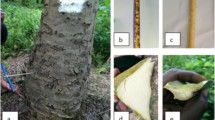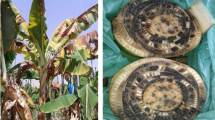Abstract
Fusarium oxysporum f. sp. passiflorae (FOP) is reported for the first time in Northland, New Zealand. The identity of this host-specific pathogen was confirmed by pathogenicity testing, morphological characters, and DNA sequencing. Pathogenic strains of Fusarium oxysporum secrete unique proteins or effectors, ‘secreted in xylem’ (SIX), which are likely to contribute to host-specific virulence. Sequence analysis of the EF-1a gene, β-tubulin and the effector genes SIX6 and SIX9 confirmed that New Zealand isolates belong to FOP. This study confirmed that the three New Zealand EF-1α haplotypes of FOP had identical SIX6 and SIX9 sequences, indicating that the same homolog of each gene, SIX6a and SIX9a, is shared by both haplotypes of FOP. SIX genes are rarely detected in non-pathogenic strains of Fusarium oxysporum species complex (FOSC) and pathogenicity tests are necessary to confirm its pathogenicity status.





Similar content being viewed by others
References
Altschul SF, Gish W, Miller W, Myers EW, Lipman DJ (1990) Basic local alignment search tool. J Mol Biol 215:403–410
Bogale M, Wingfield BD, Wingfield MJ, Steenkamp ET (2007) Species-specific primers for Fusarium redolens and a PCR-RFLP technique to distinguish among three clades of Fusarium oxysporum. FEMS Microbiol Lett 271:27–32
Cafri D, Katan J, Katan T (2005) Cross-pathogenicity between formae speciales of Fusarium oxysporum, the pathogens of cucumber and melon. J Phytopathol 153:615–622
Carbone I, Kohn L (1999) A method for designing primer sets for speciation studies in filamentous ascomycetes. Mycologia 91(3):553–556. https://doi.org/10.2307/3761358
Croll D, McDonald BA (2012) The accessory genome as a cradle for adaptive evolution in pathogens. PloS Pathog 8:e1002608
Czislowski E, Fraser‐Smith S, Zander M, O'Neill WT, Meldrum RA, Tran‐Nguyen LTT, Batley J, Aitken EAB (2018) Investigation of the diversity of effector genes in the banana pathogen, Fusarium oxysporum f. sp. cubense, reveals evidence of horizontal gene transfer. Mol Plant Pathol 19:1155–1171. https://doi.org/10.1111/mpp.12594
dos Santos Silva A, de Oliveira EJ, Haddad F, Laranjeira FF, de Jesus ON, de Oliveira SAS, de Carvalho Costa MAP, de Freitas JPX (2013) Identification of passionfruit genotypes resistant to Fusarium oxysporum f. sp. passiflorae. Trop Plant Pathol 38(3):236–242
Fisher I, Rezende JM (2008) Diseases of Passionflower (Passiflora spp.). Global Science Books
Fraser-Smith S, Czislowski E, Meldrum RA, Zander M, O’Neill W, Balali GR, Aitken EAB (2014) Sequence variation in the putative effector gene SIX8 facilitates molecular differentiation of Fusarium oxysporum f. sp. cubense. Plant Pathol 63:1044–1052
Gardner DE (1989) Pathogenicity of Fusarium oxysporum f. sp. passiflore to Banana Poka and other Passiflora spp. in Hawaii. Plant Dis 73:476–478
Glass NL, Donaldson GC (1995) Development of primer sets designed for use with the PCR to amplify conserved genes from filamentous ascomycetes. Appl Environ Microbiol 61(4):1323–1330. https://doi.org/10.1128/AEM.61.4.1323-1330.1995
Gordon DR, Martyn RD (1997) The evolutionary biology of Fusarium oxysporum. Annu Rev Phytopathol 35:111–128
Gordon TR (2017) Fusarium oxysporum and the Fusarium wilt syndrome. Annu Rev Phytopathol 55:23–29
Gordon WL (1965) Pathogenic strains of Fusarium oxysporum. Can J Botany 43:1309–1318
Hermann VE, Lecomte C (2019) Current status of Fusarium oxysporum formae speciales and races. Phytopathology 109:512–530. https://doi.org/10.1094/PHYTO-08-18-0320-RVW
Jarvis WR, Shoemaker RA (1978) Taxonomic status of Fusarium oxysporum causing foot and root rot of tomato. Phytopathology 68:1679–1680
Koyyappurath S, Atuahiva T, Le Guen R, Batina H, Le Squin H, Gautheron N, Hermann E, Peribe J, Jahiel M, Steinberg C, Liew ECY, Alabouvette C, Besse P, Dron M, Sache I, Laval V, Grisoni M (2016) Fusarium oxysporum f. sp. radicis-vanillae is the causal agent of root and stem rot of vanilla. Plant Patho J 65:612–625
Laurence MH, Summerell BA, Burgess LW, Liew ECY (2014) Genealogical concordance phylogenetic species recognition in the Fusarium oxysporum species complex. Fungal Biol 118:374–384
Leslie JF, Summerell BA (2006) The Fusarium laboratory manual. Blackwell Publishing Iowa, USA
Liberato JR, Laranjeira FF (2005) Fusarium wilt of passionfruit (Fusarium oxysporum f. sp. passiflorae) Updated on 12/21/2007 9:21:11 AM Available online: PaDIL - http://www.padil.gov.au
Lievens B, Houterman PM, Rep M (2009) Effector gene screening allows unambiguous identification of Fusarium oxysporum f. sp. lycopersici races and discrimination from other formae speciales. FEMS Microbiol Lett 300:201–215
Lievens B, Van Baarlen P, Verreth C, Kerckhove V, Rep M, Bart PHJ, Thomma, (2009) Evolutionary relationships between Fusarium oxysporum f. sp. lycopersici and Fusarium oxysporum f. sp. radicis-lypersici isolates inferred from mating type, elongation factor-1α and exopolygalacturonase sequences. Mycol Res 113:1181–1191
Lombard L, Sandoval-Denis M, Lamprecht SC, Crous PW (2019) Epitypification of Fusarium oxysporum – clearing the taxonomic chaos. Persoonia - Molecular Phylogeny and Evolution of Fungi 43. https://doi.org/10.3767/persoonia.2019.43.01
Ma LJ, van der Does H., Borkovich, K et al. (2010) Comparative genomics reveals mobile pathogenicity chromosomes in Fusarium. Nature 464, 367–373 doi10. 1038/nature08850
Mariyani N, Lombard L, Poerba YS, Subandiyah, Crous PW, Kema GHJ 2019 Phylogeny and genetic diversity of the banana Fusarium wilt pathogen Fusarium oxysporum f. sp. cubense in the Indonesian centre of origin. Stud Mycol. 2019 Mar; 92:155–194. Epub 2018 Jul 5. PMID: 30122796; PMCID: PMC6086327. https://doi.org/10.1016/j.simyco.2018.06.003
McNeill J, Barrie FR, Buck WR, Demoulin V, Greuter W, Hawksworth DL, Herendeen PS, Knapp S, Marhold K, Prado J, Prudhomme Van Reine WF, Smith GF, Wiersema JH, Turland NJ (2012) International Code of Nomenclature for algae, fungi, and plants (Melbourne Code). Gantner Verlag KG [Regnum Vegetabile no. 154].
Nelson PE (1991) Recent Advances in Fusarium Systematics: History of Fusarium systematics. Phytopathology 81:1045–1048
New Zealand Fungi and Bacteria (NZFUNGI) (2020) Landcare Research, https://nzfungi.landcareresearch.co.nz. Accessed 30 October 2020
New Zealand Passionfruit Growers Inc (2020) https://www.passionfruit.org.nz/facts-info/growing-info/diseases Accessed 30 October 2020
O’Donnell K, Gueidan C, Sink S et al (2009) A two-locus DNA sequence database for typing plant and human pathogens within the Fusarium oxysporum species complex. Fungal Genet Biol 46(12):936–948
O’Donnell K, Kistler HC, Cigelnik E, Ploetz RC (1998) Multiple evolutionary origins of the fungus causing Panama disease of banana: concordant evidence from nuclear and mitochondrial gene genealogies. PNAS USA 95:2044–2049
Olivain C, Alabouvette C (1999) Process of tomato root colonization by a pathogenic strain of Fusarium oxysporum f. sp. lycopersici in comparison with a non-pathogenic strain. New Phytol 141:497–510
O’Neill WT, Henderson J, Pattemore, JA, O’Dwyer C, et al. (2016) Detection of Fusarium oxysporum f. sp. cubense tropical race 4 strain in northern Queensland. Australas Plant Dis Notes 11:33.
Pinaria AG, Laurence MH, Burgess LW, Liew ECY (2015) Phylogeny and origin of Fusarium oxysporum f. sp. vanillae in Indonesia. Plant Pathol 64:1358–1365
Raffaele S, Kamoun S (2012) Genome evolution in filamentous plant pathogens: why bigger can be better. Nat Rev Microbiol 10:417–430
Rambaut A (2009) FigTree, Version 1.3.1. Available at: http://tree.bio.ed.ac.uk/software/figtree. Accessed 11 March 2020
Recorbet G, Steinberg C, Olivan C, Trouvelot S, Gaudot ED, Gianinazzi S, Alabouvette C (2003) Wanted: pathogenesis-related marker molecules for Fusarium oxysporum. New Phytol 159:73–92
Rep M, Kistler HC (2010) The genomic organization of plant pathogenicity in Fusarium species. Curr Opin Plant Biolo 13:420–426
Rep M, van der Does HC, Meijer M et al (2004) A small, cysteine-rich protein secreted by Fusarium oxysporum during colonization of xylem vessels is required for I-3-mediated resistance in tomato. Mol Microbiol 53:1373–1383
Rocha LO, Laurence MH, Ludowici VA et al (2016) Putative effector genes detected in Fusarium oxysporum from natural ecosystems of Australia. Plant Pathol 65:914–929. https://doi.org/10.1111/ppa.12472
Rooney-Latham S, Blomquist CL, Scheck HJ (2011) First report of Fusarium wilt caused by Fusarium oxysporum f. sp. passiflorae on passion fruit in North America. Plant Dis 95(11):1478. https://doi.org/10.1094/PDIS-03-11-0261
Sharma KD, Hemlata, Rathour R, Kapila RK, Paul YS (2018) Detection of pea wilt pathogen Fusarium oxysporum f. sp. pisi using DNA-based markers. J Plant Biochem Biotechnol 27, 342–350 https://doi.org/10.1007/s13562-018-0443-0
Snyder WC, Hansen HN (1940) The species concept in Fusarium. Am J Bot 27:64–67
Staden R, Beal K, Bonfield JK (1998) The Staden package. In: Misener S, Krawetz S (eds) Computer methods in molecular biology. Humana Press, Totowa, NJ, pp 115–130
Stamatakis A, Hoover P, Rougemont J (2008) A rapid boot-strap algorithm for the RAxML Web servers. Syst Biol 57:758–771
Summerell BA (2019) Resolving Fusarium: Current status of the genus. Annu Rev Phytopatholo 57:327–329
Taylor A, Vagany V, Jackson AC, Harrison RJ, Rainoni A, Clarkson, JP (2016) Identification of pathogenicity-related genes in Fusarium oxysporum f. sp. cepae. Mol Plant Pathol 17(7):1032–1047.
Teixeria LM, Coelho L, Donizete TN (2017) Characterization of Fusarium oxysporum isolates and resistance of passionfruit genotypes to Fusariosis. Rev Bras Fruti 39(3):e-415. Epub Aug 17, 2017. ISSN 1806–9967. https://doi.org/10.1590/0100-29452017415
Thompson JD, Higgins DG, Gibson TJ (1994) CLUSTAL W: improving the sensitivity of progressive multiple sequence alignment through sequence weighting, position-specific gap penalties and weight matrix choice. Nucleic Acids Res 22(22):4673–4680
Van Dam P, Fokkens L, Schmidt SM, Linmans JH, Kistler HC, Ma LJ, Rep M (2016) Effector profiles distinguish formae speciales of Fusarium oxysporum. Environ Microbiol 18:4087–4102
Yamashiro T, Cardoso RMG (1982) Ocorrência de murcha de Fusarium em maracujá-doce· (Passiflora alata Ait) no Estado de São Paulo. Summa Phytopathologica 8:57
Acknowledgements
The authors would like to thank Dr Merje Toome for reviewing this manuscript, Emma Scheltema for figure layout, and all the Mycology & Bacteriology team who assisted with the study.
Author information
Authors and Affiliations
Corresponding author
Rights and permissions
About this article
Cite this article
Thangavel, R., Pattemore, J.A., Rebijith, K.B. et al. Fusarium oxysporum f. sp. passiflorae infecting passionfruit in New Zealand in a changing taxonomic landscape. Australasian Plant Pathol. 50, 365–377 (2021). https://doi.org/10.1007/s13313-021-00782-4
Received:
Accepted:
Published:
Issue Date:
DOI: https://doi.org/10.1007/s13313-021-00782-4




